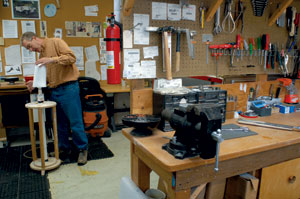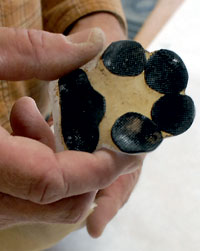Kendall Carpenter’s philosophy on animal prosthetics is simple.
“If someone asks me to do it,” he said, “I’ll do it. There’s no reimbursement for it, except that we’re here to help things.”
Carpenter, who runs Glacier Prosthetic Care, Inc., in Kalispell, never entered prosthetics – human or animal – for the money, especially in Montana. In fact, after a serious back injury debilitated him almost 20 years ago while working as a finish carpenter, he could have collected disability for the rest of his life.
Instead, he had an epiphany of sorts. Around the time of the injury, Carpenter was working on the house of John Stonecipher, a well-known prosthetist in the valley at the time. It was then he thought seriously about acting on his lifelong desire to improve people’s lives. That thinking, along with his ailing back, steered his life in a new direction.
“I was honestly appalled by the decadence of the projects I was doing here,” he said. “I wanted to do something more meaningful.”
At Glacier Prosthetic Care, which practices both prosthetics and orthotics, Carpenter believes he has fulfilled his longing to do meaningful work. He works hard with a small staff: himself, his wife Gina, who helps manage the business and does post-mastectomy care, and an office administrator, Chrystelle Armstrong. His practice is one of two prosthetics offices in the valley and one of a handful in the state.
 |
|
Kendall Carpenter works on a socket for a prosthetic leg in his workshop at Glacier Prosthetic Care, Inc., in Kalispell. |
Five years after opening the office, Carpenter has as much work as he can handle.
“Right now it’s overwhelming,” he said. “We have so much business we can’t keep up.”
A prosthesis is an artificial extension designed to replace a missing body part. Carpenter spends a portion of his time making prostheses, using a meticulous molding and vacuum-seal process. The rest of his time is split between patient interaction, other tasks and traveling to his second office in Sandpoint, Idaho.
Carpenter custom designs the prostheses. For example, if a client likes Harley Davidsons, Carpenter will make sure the socket has an image of a burly chopper on it. Orthotics, meanwhile, doesn’t involve missing body parts. It is the practice of developing and fitting support devices – braces – for deformities, abnormalities or weaknesses in the human body. Elderly people often need orthotics.
Also, Carpenter does animal prosthetics, a rare endeavor. He has made prostheses for dogs, a Sandhill Crane and a goose. For one puppy that was missing a leg, he made a prosthesis that had a paw with a textured print, which helped with traction and lifelike tracks.
“When (the dog) stepped in water,” Gina, Carpenter’s wife, said, “he would leave actual paw prints.”
Long before earning his bachelor’s and master’s degrees as well as completing his residencies at the universities of Oregon and Connecticut, Carpenter had established himself as an artist and craftsman of far-ranging versatility. He studied architecture, art and electronics at Montana State University before taking his dexterity skills into the world of finish carpentry, and eventually into prosthetics.
Instead of moving to an urban area where he would have far more customers everyday, Carpenter said he chose his Montana roots. He operates almost entirely off word-of-mouth, he said, and is close to many of his customers, some who still come to him from Cody, Wyo., where he opened his first office. He and Gina have also helped patients find housing, get back on their feet with clothing and food, and done a variety of other out-of-the-office work.
“There’s more than just making legs here,” Carpenter said.
 |
|
Kendall Carpenter holds a prosthetic leg he developed for a puppy at Glacier Prosthetic Care, Inc. The simulated paw not only gripped to help the puppy from slipping but also create more life-like paw prints. |
Carpenter is from Wolf Point and his wife is from Sidney, so they understand the difficulties of getting proper medical attention to rural areas. For this reason, Carpenter stops in Libby on the northern route to Sandpoint, and Plains and Thompson Falls on the southern route.
“We want to bring (attention) to the rural areas,” Carpenter said. “You shouldn’t be penalized for living there.”
The No. 1 reason people need amputations, Carpenter said, is diabetes. Certain cases of diabetes, if left untreated, can lead to severe nerve and blood vessel problems, and ultimately amputation. But Carpenter gets a diverse variety of patients, with no shortage of motorcycle accident victims.
He tells stories of people who come in severely restricted in their mobility, perhaps unable to walk, and leave with a new leg and a bounce in their step. It makes him smile. He said the “independence and dignity” patients gain is a “huge part of my thought process.”
“If people are brought here in a wheelchair and then they push their grandkids out, that’s a good day,” he said. “I think in life there are givers and takers. I’m a giver. I couldn’t change that if I wanted to.”